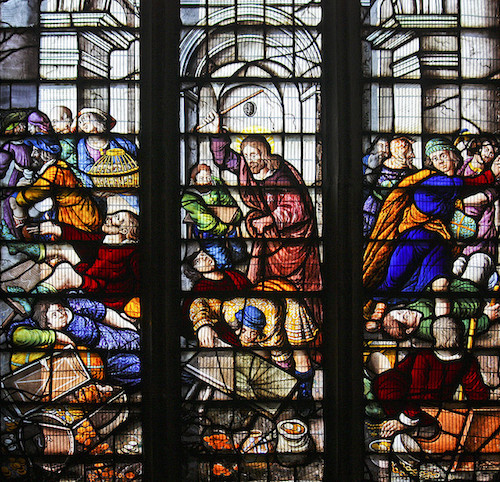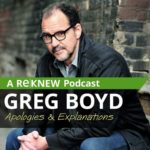We run our website the way we wished the whole internet worked: we provide high quality original content with no ads. We are funded solely by your direct support. Please consider supporting this project.

The Cleansing of the Temple and Non-Violence
Jesus’ cleansing of the Temple is the most commonly cited example of those who allege that he did not absolutize loving enemies or refraining from violence. I submit that this episode implies nothing of the sort. First, it is important that we understand that this episode was not an expression of unpremeditated anger on Jesus’ part, as some allege. Most NT scholars concur that this was a calculated, strategic act on Jesus’ part, and it contained deep symbolic significance. More specifically, this episode appears to be a classic example of a prophetic symbolic action.
There is, however, some disagreement over what exactly Jesus was symbolizing. For example, many argue that Jesus was revealing himself to be the long-awaited messiah who was widely expected to cleanse and/or restore the Temple. Others argue that Jesus was symbolically revealing Yahweh’s displeasure with the corrupt religious establishment and issuing a prophetic warning that the Temple would soon be destroyed, a point that John makes explicit (Jn 2: 19-22). While interpretations differ, however, they all presuppose that the Temple cleansing was anything but a spontaneous tantrum on the part of Jesus.
Second, there is simply no indication in any of the Gospels that Jesus resorted to violence when he cleansed the Temple. Yes, the texts suggest that Jesus was angry, and yes, John tells us that Jesus made a whip (Jn 2:15). But there is no suggestion that he used it to strike any animal or person. To the contrary, throughout history cracking a whip has been a commonly used means of controlling the movement of animals, and John explicitly reports that this is what Jesus used it for. He used the whip to create an animal stampede of “both sheep and cattle” out of the “temple courts” (Jn 2:15). Not only this, but had Jesus actually whipped any of the court officials, it is hard to imagine how he could have avoided being arrested on the spot. It is also hard to imagine how he could have avoided the charge of hypocrisy, for such behavior would have flown in the face of his previously mentioned public teachings about refraining from violence.
There is therefore nothing about Jesus’ cleansing of the temple that runs counter to my claim that the non-violent, enemy-embracing, self-sacrificial love that was supremely revealed on the cross is the thematic center of Jesus’ identity and mission. To the contrary, Jesus engaged in a kind of “street theater” out of love for his “Father’s house” as well as for the poor who were being oppressed by the corrupt leaders who ran the Temple’s “buying and selling” system. And, as the Gospels make clear, he confronted these leaders in this aggressive manner as a way of forcing their hand, and thus as a steppingstone to his crucifixion. Far from illustrating Jesus acting in an unloving, let alone violent way, I submit that this entire episode reflects Jesus’ self-sacrificial love.
Moreover, John explicitly makes the cross the thematic center of this episode, for he records that Jesus brings this episode to a close by drawing a connection between the newly cleansed temple, which Jesus prophesied would soon be permanently destroyed, and his own body, which would rise again three days after being destroyed (Jn 2:19-22). Read in context, NT scholar Richard Hays notes, John is declaring “that Jesus’ body is now the place where God dwells, the place where atonement for sin occurs, the place where the division between God and humanity is overcome.” Hence, far from counting against the thematic centrality of the cross, the Temple cleansing illustrates this centrality.
Photo credit: Lawrence OP via VisualHunt.com / CC BY-NC-ND
Category: General
Tags: Cross, Love, Non-Violence
Topics: Enemy-Loving Non-Violence
Related Reading

Jesus and the “Eye for an Eye” Command: A Response to Paul Copan (#10)
As I noted in my 9th response to Paul Copan’s critique of Crucifixion of the Warrior God (CWG), Copan argues that Jesus merely repudiated wrong applications of OT laws in his sermon on the mount, not any OT law itself. He thus thinks I’m mistaken when I argue that Jesus placed his own authority above…

Podcast: A Cross Vision Reading of David & Goliath
Dan takes a shot at interpreting the David & Goliath story through a cruciform lens. http://traffic.libsyn.com/askgregboyd/Episode_0294.mp3

ReThinking the Source of Life
Over the next few weeks, we will be exploring the twelve convictions of the ReKnew Manifesto. The first of which focuses on where we get life. In many of my writings, I speak about the source of “life.” By this I mean one’s core sense of identity, worth, significance and security. Over the years, I’ve…

Blessing the Soldiers of ISIS
In light of the overwhelming response to Greg’s post about loving the soldiers of ISIS, we thought we would explore Jesus’ teaching on this topic further. The following is an excerpt from Myth of a Christian Religion. The perspective below stands in contrast to the perspectives exhibited by many Christians, one being the recent article…

If We’re Made For Warfare, Why Non-Violence? And What Will We Fight in Heaven?
In this episode Greg talks about our warrior nature and discusses some interesting implications of that on our understanding of heaven. Links: Website: ReKnew.org http://traffic.libsyn.com/askgregboyd/Episode_0006.mp3

Violent Thinking
When most people think of violence, they think of physical violence. But the truth is that our actions are only violent because our hearts and minds are violent first. For this reason, Jesus emphasizes purging violence from our minds as much as from our physical behavior. In Matt 5:21-26, he reminds us of the OT…
